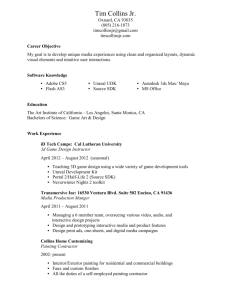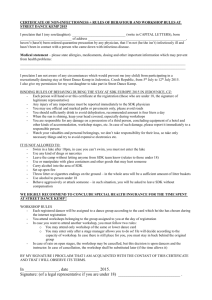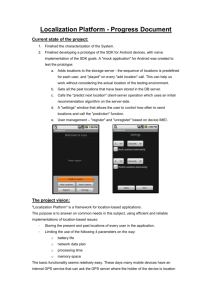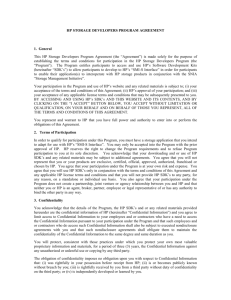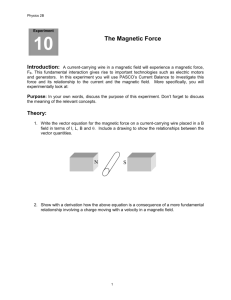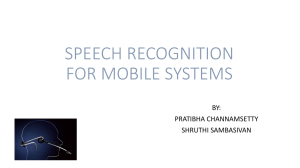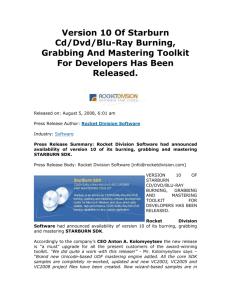Sitara - Hands-on with the Linux SDK
advertisement
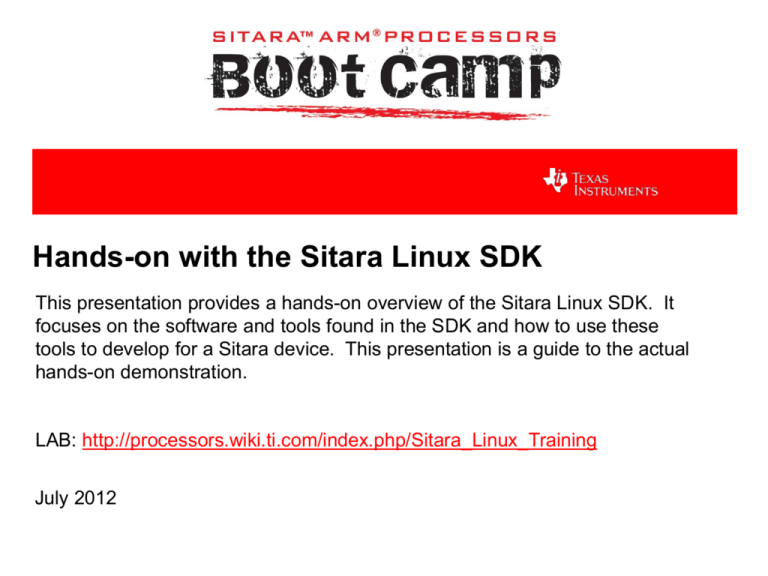
Hands-on with the Sitara Linux SDK This presentation provides a hands-on overview of the Sitara Linux SDK. It focuses on the software and tools found in the SDK and how to use these tools to develop for a Sitara device. This presentation is a guide to the actual hands-on demonstration. LAB: http://processors.wiki.ti.com/index.php/Sitara_Linux_Training July 2012 2 Pre-work Check List Installed and configured VMWare Player v4 or later Installed Ubuntu 10.04 Installed the latest Sitara Linux SDK and CCSv5 Within the Sitara Linux SDK, ran the setup.sh (to install required host packages) Using a Sitara EVM, followed the QSG to connect ethernet, serial cables, SD card and 5V power Booted the EVM and noticed the Matrix GUI application launcher on the LCD Pulled the ipaddr of your EVM and ran remote Matrix using a web browser Brought the USB to Serial cable you confirmed on your setup (preferable) 3 Agenda • SDK Overview • Obtaining the SDK • Installing the SDK • Sitara Linux SDK Directory Structure 4 What is an SDK? • Definitions and solutions vary, but we think an SDK should be…. • More than just a board support package (BSP) or a Demo – An SDK should also contain tools for developing on TI parts – Pre-built libraries that customer applications can link against without requiring building their own – Documentation • Provide a known good starting point for product development – Start with the SDK reference distributions – Add and remove packages as needed 5 Sitara Linux SDK Objectives • The purpose of the Texas Instruments Sitara Linux SDK is to provide customers with a unique out-of-box experience and a quick path to their application development. • The Sitara Linux SDK accomplishes this by providing – – – – Example applications for key, high touch IP and peripherals Tools for cross development and environment configuration Host tools for device configuration Documentation of SDK components • Out-of-box in < 10 minutes and Development in < 1 hour • A unified look and feel scaling across all Sitara devices from ARM9 to Cortex-A8 and beyond 6 Sitara Linux SDK Overview • Board Support Package (BSP) – • Documentation – • Easy installation of all target and host software components and documentation CCSv5 – – • ARM Benchmarks, Power, Multimedia, Camera, Cryptography, WLAN/Bluetooth, Profiling, 3D Graphics SDK Installer – • GUI based on PHP and HTML5 Touchscreen, Mouse & Keyboard, Web Browser Example Applications – • Quick Start Guide & SW Developer’s Guide Matrix Application Launcher – – • Linux Kernel, Bootloaders & File System Linux aware debug Preconfigured projects for example applications Host Tools – Flash Tool, PinMux Utility 7 Obtaining the SDK • The Sitara SDK is provided on an SD card in the box with the EVM – NOTE: Some boards like the BeagleBoard and BeagleBone may come without the SDK SD card in the box • Often you will want to download the latest SDK from ti.com to get updates. • There is now a central location for finding all Sitara Linux SDKs at http://www.ti.com/tool/linuxezsdk-sitara 8 Obtaining the SDK - Cont • Each SDK page contains not only the single SDK installer, but also has many individual SDK components pulled out for smaller and quicker downloads Single Installer Individual Components 9 Installing the SDK • The Sitara Linux SDK is delivered as a single installer – NOTE: The Sitara Linux SDK will also provide the option to install CCSv5 if the CCSv5 installer in found in the local directory. When installing from the SD card the CCSv5 installer is already placed in the local directory • The Sitara Linux SDK installation has been streamlined to make installation quick and easy. The customer only needs to select: – The installation location – Whether or not to install CCSv5 if present • The installer also notifies the user of important information such as – The default recommended environment – Notice of GPLv3 content within the SDK and information on how to remove it – The location of the setup scripts within the SDK for additional configuration • The installer has been designed such that “root” permission is not required to install and evaluate the SDK. 10 Sitara Linux SDK Directory Structure • bin - Contains the helper scripts for configuring the host system and target device. Most of these scripts are used by the setup.sh script. • board-support - Contains the SDK components that need to be modified when porting to a custom platform. This includes the kernel and boot loaders as well as any out of tree drivers. • docs - Contains various SDK documentation such as the software manifest and additional user's guide. This is also the location where you can find the training directory with the device training materials. • example-applications - Contains the sources for the TI provided example applications seen during the outof-box demonstration. • filesystem - Contains the reference file systems. These include the smaller base file system as well as the full-featured SDK file system. • host-tools - Contains the host side tools such as pinmux and flash tool. • linux-devkit - Contains the cross-compile toolchain and libraries to speed development for the target device. • Graphics_SDK_setuplinux_<version>.bin - This is the installer for the graphics SDK. The graphics SDK components are used by the Sitara Linux SDK to provide additional demos as well as integrated with the prebuilt Qt libraries to accelerate various Qt functions. • Makefile - Provides build targets for many of the SDK components from the top-level of the SDK. • Rules.make - Sets default values used by the top-level Makefile as well as sub-component Makefiles • setup.sh - Configures the users host system as well as the target system for development 11 For more Sitara Boot Camp sessions visit: www.ti.com/sitarabootcamp THANK YOU! 12
